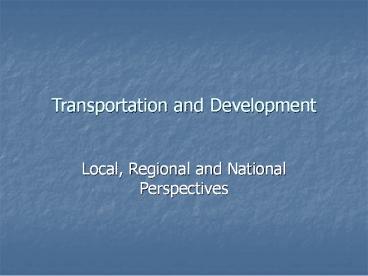Transportation and Development - PowerPoint PPT Presentation
Title:
Transportation and Development
Description:
Does transport lead or lag behind development? ... Diagram B- As transport costs are reduced, inequalities are likely to increase ... – PowerPoint PPT presentation
Number of Views:1943
Avg rating:3.0/5.0
Title: Transportation and Development
1
Transportation and Development
- Local, Regional and National Perspectives
2
Is the Transport Sector Important to Development?
- Value added by transport is estimated to account
for 3 to 5 percent of GDP. - Public investment in transport typically
accounts for between 2.0 and 2.5 percent of GDP
and may rise as high as 3.5 percent in countries
modernizing outdated transport infrastructure or
building new transport infrastructure - Transport likewise commonly accounts for
5 to 8 percent of total paid employment
3
Public Infrastructure Investment Is Large
Proportion of Total and Public Investment in
Developing Countries
4
Countries with Decentralized Road Maintenance
Have Better Roads
5
Is Transport Sector Important to Development?
- Demand for freight and passenger transport
in most developing and transition countries
is growing 1.5 to 2.0 times faster than GDP
-the bulk of this increase is for road
transport. - Although demand for freight transport (except air
transport) in industrialized countries grows less
rapidly than GDP, in developing and transitional
countries the growth rate is closer to that for
passenger transport - In 1996 private sector lending to emerging
markets peaked at 196 billion. Since then
it has fallen sharply and estimates for 1999
are just over 17 billion.
6
Transport Sector Issues
- Globalization of trade. Advances in
international logistics (for example, multi-
modal transport technology,
e-documentation, streamlined customs procedures,
etc.) have greatly expanded the scope for
international trade in goods and
services - Congestion and pollution Growing road
congestion, particularly in cities, generates
pollution and increases road accidents
(about 500,000 persons per annum are
killed in road accidents
7
Transport Sector Issues
- Transport sector deficits Poorly managed
public transport services impose a heavy
burden on public finance (for example, until
recently, the transport sector deficit in Zambia
absorbed 12 percent of the governments total
current revenues) - Expenditure needs Large sums of money are
required to maintain and modernize
existing transport infrastructure (for example,
road spending alone often accounts for 10 percent
to 20 percent of the governments development
budget)
8
What Do We Know about Transport and Development?
- Certain minimum level of transport is essential
to allow development - Generally accepted necessary but not sufficient
condition for development - No general agreement about size of transport
sector and its causal relationships with other
sectors - Remain uncertain about its inducement properties
and role as catalytic agent
9
Investment Strategies
- Supply Strategy- if we create transport
infrastructure we assume that it will create its
own demand - This strategy not always realistic because it
raises the issue of lag and lead effects - Does transport lead or lag behind development?
- Best to view this as a circular, mutually
reinforcing process
10
Lag and Lead Effects Circular and Mutually
Reinforcing Process
11
Transport Impacts
- Economic
- Allows market development
- Extraction of resources
- Stimulates employment
- Political
- Facilitates administration
- Promotes national integration
- Social
- Information diffusion
- Communication
12
Transport Impacts on Economic Growth
Transport Improvements
Commodity Market
Labor Market
Expansion
New Activities
Growth
13
Economic Production and Specialization
Region B
Region A
Self Reliance
Regional Trade
Trade and Transport
Trade and Transport
International Trade
Product A
Product B
Product C
Product D
Gateway
Product E
14
Possible Effects of Transport Improvements
- Positive Growth- reduction in resource
expenditure for distribution prior dynamism
argument-growth capacity already present
transport releases tight constraint - Slowing Growth- use of scarce resources
instead of investing in alternatives-lost
opportunity costs overinvestment in sector - Negative Growth- access encourages new
competition and new products enter market
from outside depress local industries
15
Impact of Transport Cost Reductions on Inequality
Center
Periphery
A
B
C
Inequalities
Globalization
Transport Costs
16
Inequalities and Transport Costs
- Improvements in transport and reduction in
costs imply two major consequences 1/
exploitation of comparative advantage and 2/
development of economies of scale - Diagram A- High transport costs and
relatively low level of inequalities - Diagram B- As transport costs are reduced,
inequalities are likely to increase since
economies of scale are the first to benefit - Diagram C- further improvements in transport
infrastructures favor a more efficient use of
comparative advantages, a relocation of
economic activities in the periphery and a
wider access to the markets of the center.
The likely outcome is a decline in inequalities
17
Process Model of Transports Role in Regional
Development
- Stage I- Road development-often simple- plays
role in administration, political
cohesion, and extracting natural resources - Stage II- Road transport important but rail
begins to compete- more stable system with intent
to link and secure regions more broadly - Stage III- Road again is dominant as links
penetrate often remote rural areas to allow
delivery of health services and marketing
18
Ideal Typical Sequence of Transport Development
A
B
C
D
E
F
19
Challenges and Trends in Rural Transport
- Lack of Rural Transport Policy and Strategy
- Weak Management Capacity at Local Levels after
Decentralized Decision-making - Inadequate Financing and Standards
- Planning and Selection Processes have Withered
Away - Promoting Private Provision of Rural Transport
Services - Promoting Non-motorized Transport
20
(No Transcript)































